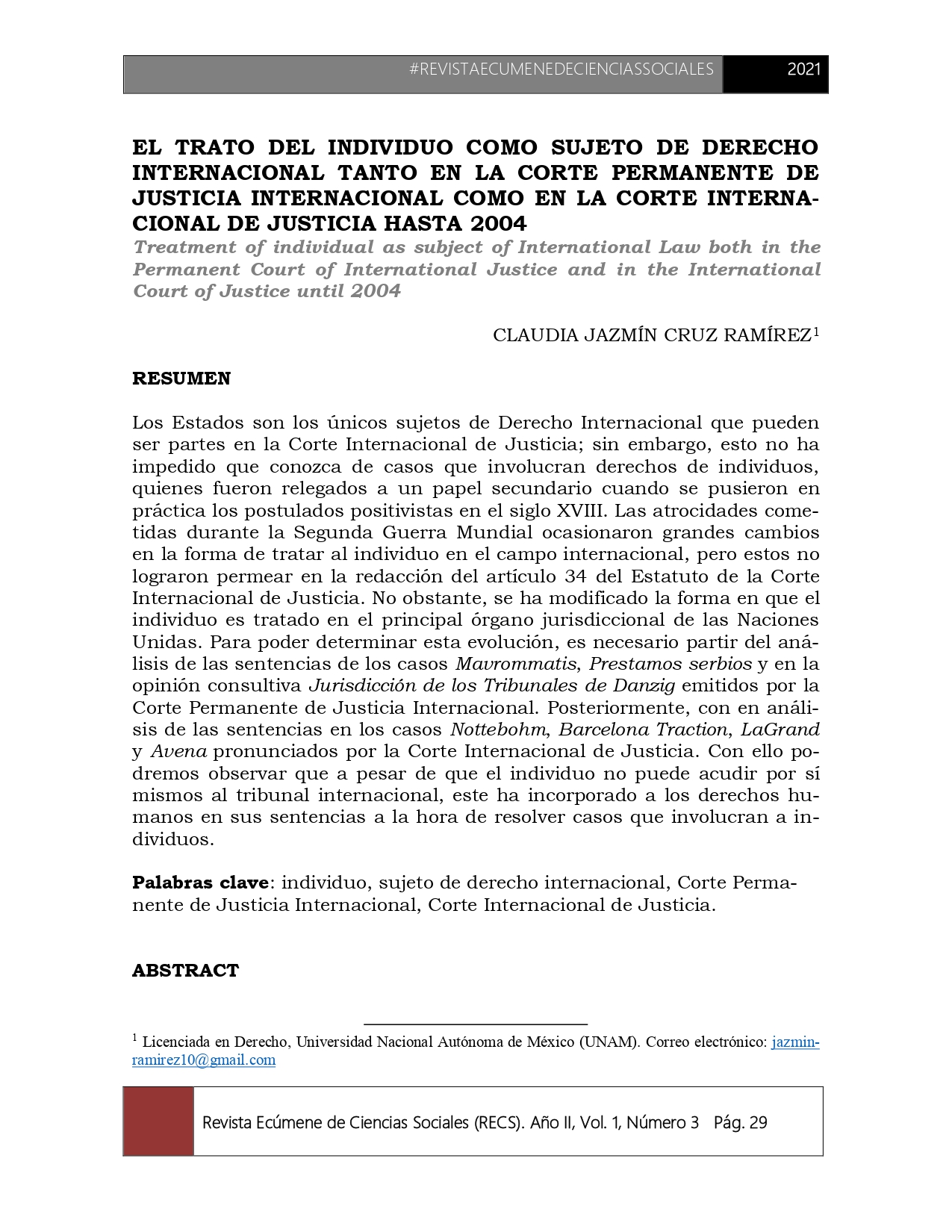Resumen
Los Estados son los únicos sujetos de Derecho Internacional que pueden ser partes en la Corte Internacional de Justicia; sin embargo, esto no ha impedido que conozca de casos que involucran derechos de individuos, quienes fueron relegados a un papel secundario cuando se pusieron en práctica los postulados positivistas en el siglo XVIII. Las atrocidades cometidas durante la Segunda Guerra Mundial ocasionaron grandes cambios en la forma de tratar al individuo en el campo internacional, pero estos no
lograron permear en la redacción del artículo 34 del Estatuto de la Corte Internacional de Justicia. No obstante, se ha modificado la forma en que el individuo es tratado en el principal órgano jurisdiccional de las Naciones Unidas. Para poder determinar esta evolución, es necesario partir del análisis de las sentencias de los casos Mavrommatis, Prestamos serbios y en la opinión consultiva Jurisdicción de los Tribunales de Danzig emitidos por la Corte Permanente de Justicia Internacional. Posteriormente, con en análisis de las sentencias en los casos Nottebohm, Barcelona Traction, LaGrand y Avena pronunciados por la Corte Internacional de Justicia. Con ello podremos observar que a pesar de que el individuo no puede acudir por sí mismos al tribunal internacional, este ha incorporado a los derechos humanos en sus sentencias a la hora de resolver casos que involucran a individuos
Referencias
Advisory Committee of Jurists, Procès-verbaux of the Proceedings of the Committe. June 16th – July 24th 1920 with Annexes. Países Bajos: Van Langenhuysen Brothers, 1920, https://archive.org/details/procsverbauxof00leaguoft/page/204.
Damrosch, Lori F. et al. International Law. Cases and Materials. 5a ed. Estados Unidos: West, American Casebook Series, 2009.
Anzilotti, Dionisio. Corso de Diritto Internazionale, tomo I. 3ª ed. Traducido por Julio López Olivan. España: Reus, 1935.
Hudson, Mainley O. The Permanent Court of International Justice 1920 -1942. A treatise. Estados Unidos: The MacMillan Company, 1943.
Kolb, Robert. The International Court of Justice. Traducido por Perry Alan. Estados Unidos: Hart Publishing, 2013.
League of Nations, Committee of Jurist on the Statute of the Permanent Court of International Justice. Minutes of the Sessions held at Geneva, March 11th – 19th, 1929. Suiza: Series League of Nations Publications, 1929. https://www.icj-cij.org/public/files/permanent-court-ofinternationaljustice/serie_D/D_minutes_statut_PCIJ_11au19march_1929.pdf.
Nijman, Janne Elisabeth. The Concept of International Legal Personality. An Inquiry into the History and Theory of International Law. Países Bajos: T M C Asser Press, 2004.
Portmann, Roland. Legal Personality in International Law. Estados Unidos: Cambridge University Press, 2010.
Parlett, Kate. The individual in the International Legal System. Continuity and Change in International Law, Reino Unido: Cambirdge University Press, 2011.
Remec, Peter Pavel. The Position of the Individual in International Law according to Grotius and Vattel. Países Bajos: Martinus Nijhoff, 1960.
Vattel, Emer, The Law of Nations, or, principles of the Law of Nature, Applied to the Conduct and Affairs of Nations and Sovereigns, with Three Early Essays on the Origin and Nature of Natural Law and Luxury, trad. de Thomas Nugent. Estados Unidos: Liberty Fund, 2008.
Spiermann, Ole, International Legal Argument in the Permanent Court of International Justice. The Rise of the International Judiciary. Estados Unidos: Cambridge University Press, 2005.
United Nations Information Organization, Documents of the United Nations Conference on International Organization, San Francisco, 1945. Volume XIV United Nations Committee of Jurist. Estados Unidos, The Library of Congress, 1945.

Esta obra está bajo una licencia internacional Creative Commons Atribución-NoComercial-CompartirIgual 4.0.

